Jonas Becker
Stay Focused: Problem Drift in Multi-Agent Debate
Feb 26, 2025Abstract:Multi-agent debate - multiple instances of large language models discussing problems in turn-based interaction - has shown promise for solving knowledge and reasoning tasks. However, these methods show limitations, particularly when scaling them to longer reasoning chains. In this study, we unveil a new issue of multi-agent debate: discussions drift away from the initial problem over multiple turns. We define this phenomenon as problem drift and quantify its presence across ten tasks (i.e., three generative, three knowledge, three reasoning, and one instruction-following task). To identify the reasons for this issue, we perform a human study with eight experts on discussions suffering from problem drift, who find the most common issues are a lack of progress (35% of cases), low-quality feedback (26% of cases), and a lack of clarity (25% of cases). To systematically address the issue of problem drift, we propose DRIFTJudge, a method based on LLM-as-a-judge, to detect problem drift at test-time. We further propose DRIFTPolicy, a method to mitigate 31% of problem drift cases. Our study can be seen as a first step to understanding a key limitation of multi-agent debate, highlighting pathways for improving their effectiveness in the future.
Voting or Consensus? Decision-Making in Multi-Agent Debate
Feb 26, 2025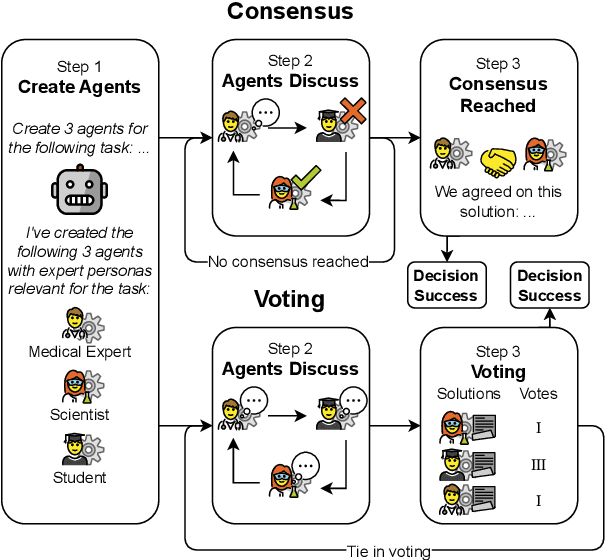
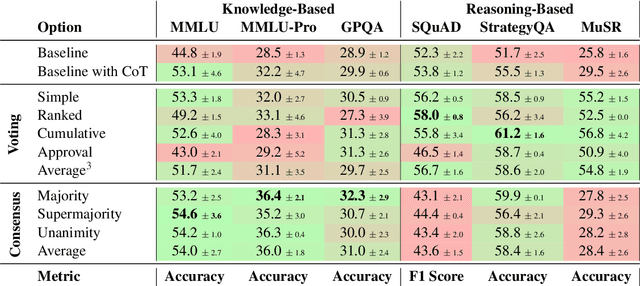
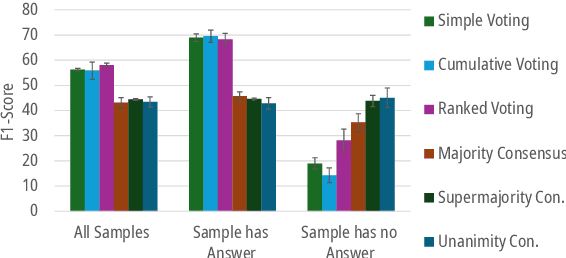

Abstract:Much of the success of multi-agent debates depends on carefully choosing the right parameters. Among them, the decision-making protocol stands out. Systematic comparison of decision protocols is difficult because studies alter multiple discussion parameters beyond the protocol. So far, it has been largely unknown how decision-making addresses the challenges of different tasks. This work systematically evaluates the impact of seven decision protocols (e.g., majority voting, unanimity consensus). We change only one variable at a time (i.e., decision protocol) to analyze how different methods affect the collaboration between agents and test different protocols on knowledge (MMLU, MMLU-Pro, GPQA) and reasoning datasets (StrategyQA, MuSR, SQuAD 2.0). Our results show that voting protocols improve performance by 13.2% in reasoning tasks and consensus protocols by 2.8% in knowledge tasks over the other decision protocol. Increasing the number of agents improves performance, while more discussion rounds before voting reduces it. To improve decision-making by increasing answer diversity, we propose two new methods, All-Agents Drafting (AAD) and Collective Improvement (CI). Our methods improve task performance by up to 3.3% with AAD and up to 7.4% with CI. This work demonstrates the importance of decision-making in multi-agent debates beyond scaling.
Multi-Agent Large Language Models for Conversational Task-Solving
Oct 30, 2024Abstract:In an era where single large language models have dominated the landscape of artificial intelligence for years, multi-agent systems arise as new protagonists in conversational task-solving. While previous studies have showcased their potential in reasoning tasks and creative endeavors, an analysis of their limitations concerning the conversational paradigms and the impact of individual agents is missing. It remains unascertained how multi-agent discussions perform across tasks of varying complexity and how the structure of these conversations influences the process. To fill that gap, this work systematically evaluates multi-agent systems across various discussion paradigms, assessing their strengths and weaknesses in both generative tasks and question-answering tasks. Alongside the experiments, I propose a taxonomy of 20 multi-agent research studies from 2022 to 2024, followed by the introduction of a framework for deploying multi-agent LLMs in conversational task-solving. I demonstrate that while multi-agent systems excel in complex reasoning tasks, outperforming a single model by leveraging expert personas, they fail on basic tasks. Concretely, I identify three challenges that arise: 1) While longer discussions enhance reasoning, agents fail to maintain conformity to strict task requirements, which leads to problem drift, making shorter conversations more effective for basic tasks. 2) Prolonged discussions risk alignment collapse, raising new safety concerns for these systems. 3) I showcase discussion monopolization through long generations, posing the problem of fairness in decision-making for tasks like summarization. This work uncovers both the potential and challenges that arise with multi-agent interaction and varying conversational paradigms, providing insights into how future research could improve the efficiency, performance, and safety of multi-agent LLMs.
Text Generation: A Systematic Literature Review of Tasks, Evaluation, and Challenges
May 24, 2024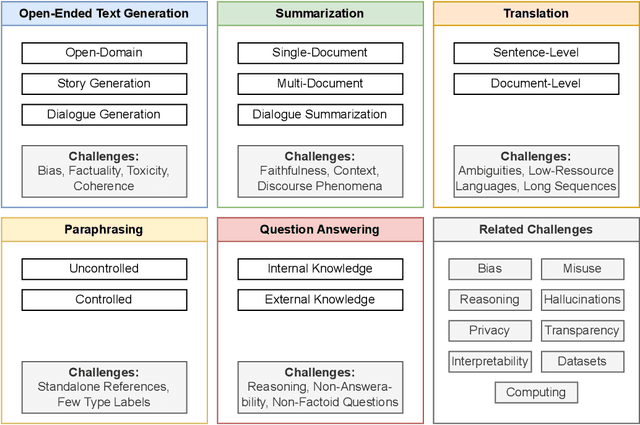


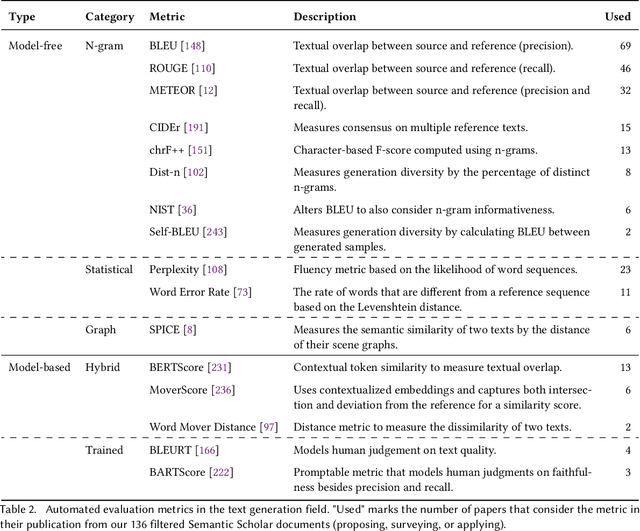
Abstract:Text generation has become more accessible than ever, and the increasing interest in these systems, especially those using large language models, has spurred an increasing number of related publications. We provide a systematic literature review comprising 244 selected papers between 2017 and 2024. This review categorizes works in text generation into five main tasks: open-ended text generation, summarization, translation, paraphrasing, and question answering. For each task, we review their relevant characteristics, sub-tasks, and specific challenges (e.g., missing datasets for multi-document summarization, coherence in story generation, and complex reasoning for question answering). Additionally, we assess current approaches for evaluating text generation systems and ascertain problems with current metrics. Our investigation shows nine prominent challenges common to all tasks and sub-tasks in recent text generation publications: bias, reasoning, hallucinations, misuse, privacy, interpretability, transparency, datasets, and computing. We provide a detailed analysis of these challenges, their potential solutions, and which gaps still require further engagement from the community. This systematic literature review targets two main audiences: early career researchers in natural language processing looking for an overview of the field and promising research directions, as well as experienced researchers seeking a detailed view of tasks, evaluation methodologies, open challenges, and recent mitigation strategies.
Paraphrase Detection: Human vs. Machine Content
Mar 24, 2023Abstract:The growing prominence of large language models, such as GPT-4 and ChatGPT, has led to increased concerns over academic integrity due to the potential for machine-generated content and paraphrasing. Although studies have explored the detection of human- and machine-paraphrased content, the comparison between these types of content remains underexplored. In this paper, we conduct a comprehensive analysis of various datasets commonly employed for paraphrase detection tasks and evaluate an array of detection methods. Our findings highlight the strengths and limitations of different detection methods in terms of performance on individual datasets, revealing a lack of suitable machine-generated datasets that can be aligned with human expectations. Our main finding is that human-authored paraphrases exceed machine-generated ones in terms of difficulty, diversity, and similarity implying that automatically generated texts are not yet on par with human-level performance. Transformers emerged as the most effective method across datasets with TF-IDF excelling on semantically diverse corpora. Additionally, we identify four datasets as the most diverse and challenging for paraphrase detection.
 Add to Chrome
Add to Chrome Add to Firefox
Add to Firefox Add to Edge
Add to Edge